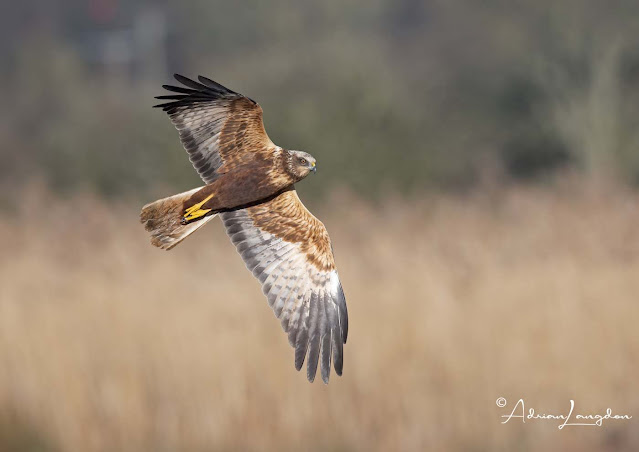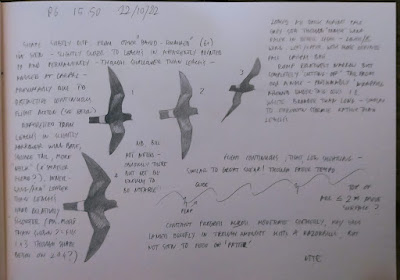SEAWATCHING in Cornwall is my main interest in birding, mainly because the county lends itself perfectly to an incredible passage of seabirds and a its also a brilliant opportunity to find your own birds.
This summer and autumn has been exceptional and arguably better than 2022. The following is a synopsis of around 250 hours pure seawatching from two prime sites in West Cornwall: Pendeen and Porthgwarra.
Summary: there are many highlights but the following are the best and worthy of mention:
Fea's Petrel: two sightings, 30th July at Porthgwarra and then a personal find of one at Pendeen on 25th August. The latter was extra special because it was my first from Pendeen. Fea's are super rare here and very few birders have even seen one from Pendeen.
Wilson's Petrel: 25 seen in a five week period including at least six personal finds.
Sabine's Gull: 34 seen with a personal recent best of 16 in one day but also finding a flock of 11 adults together at Pendeen.
Common Scoter: hardly a major rarity but we set a county record of 1115 in one day at Pendeen.
Scopoli's Shearwater: two very good candidates for this species which saw an unprecedented influx in to Cornish waters, including the county first at Porthgwarra 8th July, (subject to acceptance) and another off Pendeen.
Cory's Shearwater: witness to the Cornwall high record count of 6500 birds off Porthgwarra, 30th July.
Sooty Shearwater: a personal highlight with Paul Marshall in counting Cornwall's highest ever day count of 705 birds.
Pomarine Skua: a good year with 46 birds recorded but one stand out highlight was finding a flock of six off Pendeen in August.
Species accounts:
Great Shearwater: seen on 38 occasions with the first sighting on 23rd June at Porthgwarra and the last on 20th November at Pendeen. The majority were seen in a six week period from mid Aug to end of Sept. A personal high total of 1794 was counted on 31st August at Porthgwarra. A second high count of 414 passed Pendeen on 25th Aug. Even higher counts were noted from Falmouth Bay and Lizard watchpoints. This species was one of the ever-present large shears throughout the summer and autumn and gave many birders their first opportunity to observe at close quarters.
Cory's Shearwater: seen on 44 occasions with the first sighting on 4th July at Porthgwarra and the last on 21st October at Porthgwarra. This species was ever-present during the summer months and not just from far west watchpoints. Falmouth Bay attracted equally large numbers and as the summer progressed, birders were even treated in East Cornwall and Devon, normally exceptionally rare here. A massive flock of a minimum 6500 birds passed Porthgwarra on the 30th July. This is a county record. (An astonishing 16,000 were logged on the same day in Scilly). Two more four-figure counts included 1291 on the 12th August and 1211 on 1st Sept, all at Porthgwarra, which is the UK's prime site for this species. The prime time to see this species is the last week of July to the end of August.
Sooty Shearwater: an exceptional year for this species and the county single day count of 705 was easily the highest ever recorded on 29th Oct at Porthgwarra. Even more unusual is the late timing for this count. The breeding season for Sooty Shearwater starts at the end of October and adults should be sitting by mid Nov latest. Thus, its a fairly safe bet that these late birds are non breeders. (Sooty takes six years to reach maturity).
At least 14 birds were seen from January to end of March, most likely indicating a small number of non breeders wintering in the south west Approaches. The first "summer" record was two off Porthgwarra on 17th June. Thereafter seen in small numbers on every seawatch. The first significant number of 42 appeared on 30th July. Triple figure counts included 705 29th Oct, 102 2nd Nov, 145 18th Nov, 223 20th Nov. Prime time to see this stunning southern breeder is mid Aug to mid Nov. Of interest, the Cornwall rolling ten year average is just 728 birds up to 2021, clearly indicating an exceptional year.
Little Shearwater: a Barolo type was seen on three days on 14th, 16th and 17th July. Sadly I wasn't at Porthgwarra when it was found. Martin Elliott found it mid pm at Porthgwarra and it was seen well by several other birders. (note: it was also probably seen on the 13th by Ryan Irvine and announced as a probable but not claimed at the time). This key find (10th for Cornwall) further confirms the month of July is massively important for rare seabirds.
Balearic Shearwater: the rarest and most threatened shearwater. Numbers seemed well down on previous years and was missing from many day counts. Peak passage is short and starts last week of August through to third week of Sept. Just two day counts of three-figures included 121 on 18th Sept and 118 on the 22nd, both from Pendeen. The first record was 10th June at Porthgwarra and finally two at Pendeen on the 19th Nov.
Wilson's Petrel: An incredible 25 were logged between 1st July and 8th August. The dates indicate quite a tight viewing period and as repeated again, confirms that July is an important month for seawatching, especially petrels. Ignore July at your peril! Saturday 5th August was the highest count of 11 at Pendeen though I missed some and personally saw five. The next high count was six from Porthgwarra on the 4th July. 11 of the sightings came from Porthgwarra and 14 from Pendeen. No site holds a Wilson's trump card. 2023 easily surpasses all my previous Wilson's counts. Improved optics, more confidence in id at distance plays a part but the general consensus is an increase in numbers from the Southern Atlantic.
European Storm Petrel: Seen on 50 seawatching occasions. The first for the year was actually on 1st Jan at Pendeen, but normal sightings commenced 18th June with one at Porthgwarra. The first significant counts started 1st July with 144 at Pendeen and then 75 at Porthgwarra on 4th July. Three figure counts are always worth mentioning and my highest count of the year was 206 at Porthgwarra on 8th Aug.
A perplexing influx occurred after a big westerly storm on the 2nd Nov, with 118 on the 2nd and another 105 on the 4th Nov. None were seen in all October, so presumably these late birds were further north breeders caught up in a big Atlantic storm while heading south. The species winters off Namibia west to the Cape and Natal.
Leach's Petrel: Just six birds were logged this year, all from Pendeen. The species is rare from Porthgwarra. The maximum day count was three birds, 22nd Sep at Pendeen, then three singles, 14th Oct, 1st Nov and 2nd Nov. Some observers failed to year tick Leach's. Inexplicably, Kent and other south coast sites reported high numbers including over 200. Strong weather must have pushed them down the east coast rather than their normal west coast route.
Pomarine Skua: A really good year with 46 birds and recorded on 22 occasions. First sighting of the year was one in Falmouth Bay on 8th Jan. Up to five winter here and have done so for the last few years. "Normal" sightings commenced 5th May with two stunning adults, photo'd off Porthgwarra. Non-breeders were seen regularly through the summer. Return passage started on 25th Aug with a group of six birds together past Pendeen, a stunning sight to behold. This species is one of my favourites and no seawatch is complete without a Pom. Another six were logged past Pendeen on the 2nd Nov. An interesting stat is 23 of the total (50%) were seen from 20th October to 20th Nov. The species clearly moves south quite late, probably because it breeds so far north in to Arctic Russia.
Great Skua: A total of 73 birds seen on 30 occasions during the year but only once achieved a double figure count of 12 on 2nd Nov at Pendeen. There is some minor duplication of numbers, especially at Porthgwarra where non breeders spend the summer. All other counts were between one and six. This species has taken a massive hit due to bird flu and being top of the food chain. Just one juv was seen.
Long-tailed Skua: Just three birds seen this year, which is a decent number. This species is the rarest of the Stercorarius group and requires a good description, photos and ideally more than one observer to get this species past the rarities committee. Its always a big call on a seawatch and when one flies past, there's always excitement. In 40 years of seawatching records, I have only seen 21 birds.
This year's three birds were seen on 22nd Aug at Pendeen, 23rd Sep and 29th Oct at Porthgwarra. No west Cornwall site holds the trump card, though the Lizard birders have had more joy with this species.
Arctic Skua: Seen on 49 seawatch occasions with a total of 319 birds. The first sighting of the year was three at Porthgwarra on 18th June and thereafter seen on most days in single or pairs throughout the Aug to Nov period. Spring passage for this species is unusual and I would describe Arctic Skua as scarce to rare at this time of year. Return Autumn passage is more obvious and commenced 25th Aug with 145 seen in the following month to 24th Sept. There was a pause in sightings until the last two weeks of October when another 96 birds passed Pendeen. The pause may mean nothing more than suitable wind direction attracting birds closer to the coast.
Sabine's Gull: 34 birds seen on seven occasions, all from Pendeen and six in a flock from the Scillonian. Sabine's is rare from Porthgwarra. The last week of August is clearly prime time though four on 14th October is notable. The highlight was a self-found flock of 11 birds off Pendeen on the 22nd August, all adults. A total of 16 were seen on this morning, my highest ever day count since that famous day at at St Ives in Sept 83.
Little Gull: A good autumn passage peaking at the end of October to first week Nov. Highlights were 16 on 21st Oct and 13 2nd Nov. These numbers coincided with high numbers moving down the North Sea.
Black Tern: a poor year with just eight birds seen, all from Pendeen, end of August.
Great Northern Diver: Logged on 24 seawatches. Spring migration was limited to just four birds in May and June from Porthgwarra. All were adults moving west. The species leaves Cornwall relatively late. Its always an odd surprise to see an adult Great Northern in full breeding plumage in late June in Cornwall. Autumn passage starts last week of October and lasts approx four weeks; thereafter, the species is seen in singles or pairs on most seawatches in the winter.
Red-throated Diver: the "default" small diver, always seen from Pendeen but hardly in great numbers. 15 were logged end of March.
More to follow...
7/12/2023.
















